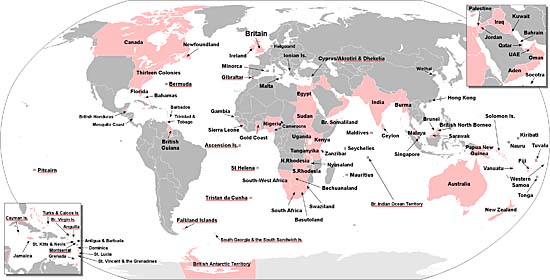
Unit 4: Nationalism, Industrialism, and Imperialism
Lesson B: Resistance to European Rule in India and SE Asia
Lesson Overview
As European countries industrialized, they needed resources and markets for their goods. Europeans tried to fulfill these needs by securing colonies in South and Southeast Asia. These colonies served both economic and military purposes. As time went on, European countries gained wealth and power. The country that had the most territory was Great Britain. "The Sun Never Sets on the British Empire" was a phrase that suggested there was always daylight somewhere in the British Empire. At the same time, some Asian populations became frustrated by their limited economic opportunities and political power. As a result, nationalism increased throughout Asia. Some native peoples rebelled and tried to push Europeans out of their lands.
Key Questions
- How and why did imperialism transform political, economic, and social systems?
- Why did nationalism grow as a result of imperialism?
Student Outcomes
- Analyze the reasons for British imperialism in India, including the decline of the Mughal Empire and the economic potential of Indian crops.
- Assess the economic impact of British imperialism, including deindustrialization, on India. Also assess the impact on farmers, manufacturers, and world trade.
- Explain the social, economic, and intellectual sources of Indian nationalism and analyze the reactions of the British government to it.
- Compare French and British colonial expansion in mainland Southeast Asia and analyze Thailand's success in avoiding colonization.
- Evaluate multiple perspectives of various peoples in the past by demonstrating their differing motives and beliefs. (Historical Thinking Skill)
- Identify the author or source of the historical document or narrative and assess its credibility. (Historical Thinking Skill)
Key Terms
Student Resources
- Historical Investigation: The Development of Nationalism in India (doc)
- Southeast Asia Jigsaw Factsheets (pdf)
- Southeast Asia Jigsaw Organizer (doc)
- An Editorial - Should European Countries Keep Asian Colonies? (doc)
Chart of Activities
| Activities to Complete | Estimated Time |
|---|---|
| Pre-Assessment | 5 minutes |
| Key Terms | 5 minutes |
| Activator: The World 1815-1914 | 5 minutes |
| Opening: European Imperialism | 10 minutes |
| Activity 1: The Creation of British India | 10 minutes |
| Activity 2: Examining Perspective - The Lion and the Tiger | 15 minutes |
| Activity 3: Examining Perspective - British Soldiers Looting | 10 minutes |
| Activity 4: Examining Perspective - The Capture of the King | 20 minutes |
| Activity 5: Examining Perspective - Hand Car | 20 minutes |
| Activity 6: The Impact of British Rule on India | 15 minutes |
| Activity 7: Growth of Nationalism in India | 15 minutes |
| Activity 8: Southeast Asia - Comparisons | 15 minutes |
| Activity 9: Examining Perspective through Letters | 15 minutes |
| Review and Assessment | 15 minutes |
| Lesson Summary | 5 minutes |
Lesson Completion Time
The total estimated time to complete this lesson is 180 minutes.
Page Notes:
[1] Source: This image from http://en.wikipedia.org/wiki/File:The_British_Empire.png is in the public domain.



